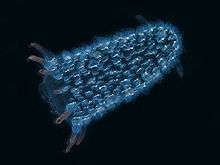Pyrosome
| Pyrosoma | |
|---|---|
 | |
| A young pyrosome colony found off Atauro Island, East Timor (length about 1 cm). | |
| Scientific classification | |
| Kingdom: | Animalia |
| Phylum: | Chordata |
| Subphylum: | Tunicata |
| Class: | Thaliacea |
| Order: | Pyrosomida |
| Family: | Pyrosomatidae |
| Genus: | Pyrosoma |
Pyrosomes, genus Pyrosoma, are free-floating colonial tunicates that live usually in the upper layers of the open ocean in warm seas, although some may be found at greater depths. Pyrosomes are cylindrical- or conical-shaped colonies made up of hundreds to thousands of individuals, known as zooids. Colonies range in size from less than one centimeter to several metres in length.
Each zooid is only a few millimetres in size, but is embedded in a common gelatinous tunic that joins all of the individuals. Each zooid opens both to the inside and outside of the "tube", drawing in ocean water from the outside to its internal filtering mesh called the branchial basket, extracting the microscopic plant cells on which it feeds, and then expelling the filtered water to the inside of the cylinder of the colony. The colony is bumpy on the outside, each bump representing a single zooid, but nearly smooth, though perforated with holes for each zooid, on the inside.
Pyrosomes are planktonic, which means their movements are largely controlled by currents, tides, and waves in the oceans. On a smaller scale, however, each colony can move itself slowly by the process of jet propulsion, created by the coordinated beating of cilia in the branchial baskets of all the zooids, which also create feeding currents.
Pyrosomes are brightly bioluminescent, flashing a pale blue-green light that can be seen for many tens of metres. The name Pyrosoma comes from the Greek (pyro = "fire", soma = "body"). Pyrosomes are closely related to salps, and are sometimes called "fire salps". Sailors on the ocean are occasionally treated to calm seas containing many pyrosomes, all luminescing on a dark night.
Bioluminescence
Although many planktonic organisms are bioluminescent, pyrosome bioluminescence is unusual in its brilliance and sustained light emission,[1] and evoked the following comment when seen by scientist T.H. Huxley at sea:
"I have just watched the moon set in all her glory, and looked at those lesser moons, the beautiful Pyrosoma, shining like white-hot cylinders in the water" (T.H. Huxley, 1849).[2]

Pyrosomes often exhibit waves of light passing back and forth through the colony, as each individual zooid detects light and then emits light in response. Each zooid contains a pair of light organs located near the outside surface of the tunic, which are packed with luminescent organelles that may be intracellular bioluminescent bacteria. The waves of bioluminescence that move within a colony are apparently not propagated through neurons, but by a photic process.[3] Flashing zooids not only stimulate other zooids within the colony to bioluminesce, but nearby colonies will also display bioluminescence in response. Colonies bioluminesce in response to mechanical stimulation (touch), as well as to light.[1]
Species

The following species are accepted as valid by the World Register of Marine Species:[4]
- Pyrosoma aherniosum Seeliger, 1895
- Pyrosoma atlanticum Péron, 1804
- Pyrosoma godeauxi van Soest, 1981
- Pyrosoma ovatum Neumann, 1909
References
- 1 2 Bowlby, M.R.; E.A. Widder; J.F. Case (1990). "Patterns of stimulated bioluminescence in two pyrosomes (Tunicata: Pyrosomatidae)". Biological Bulletin (Marine Biological Laboratory) 179 (3): 340–350. doi:10.2307/1542326. JSTOR 1542326.
- ↑ Huxley, J. (1936). T.H. Huxley's Diary of the Voyage of H.M.S. Rattlesnake. Garden City, New York: Doubleday.
- ↑ Mackie, G.O.; Bone, Q. (1978). "Luminescence and associated effector activity in Pyrosoma (Tunicata: Pyrosomida)". Proceedings of the Royal Society B 202 (1149): 483–495. doi:10.1098/rspb.1978.0081.
- ↑ "Pyrosoma". World Register of Marine Species. Retrieved April 13, 2015.
- Bone, Q. editor (1998) The Biology of Pelagic Tunicates. Oxford University Press, Oxford. 340 pp.
External links
| Wikimedia Commons has media related to Pyrosoma. |
- Huge pyrosome captured in the North Atlantic - story and images
- Some nice images taken by divers off southern California
- The Bioluminescence Web Page
- Divers with huge southern hemisphere pyrosomes
- R R Helm (1 August 2013). "The 60 foot long jet powered animal you’ve probably never heard of". Deep Sea News. External link in
|publisher=(help)